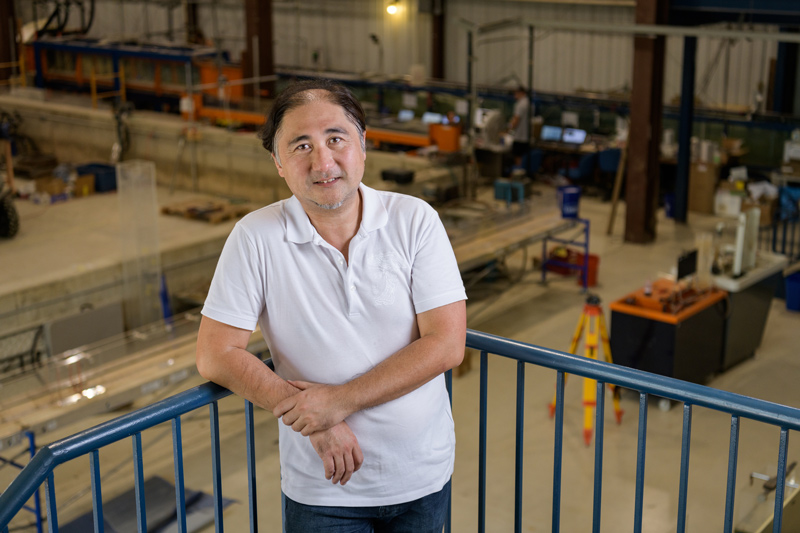


With a grain of sand
Photo by Evan Krape September 09, 2021
UD professor takes home prestigious Hans Albert Einstein Award for work on sediment transport
As a husband and a father of three young children, Tian-Jian Hsu (otherwise known as Tom) admits he is not the ultimate beach companion. When the family heads out for a seaside getaway, something they try to do at least a few times per summer, Hsu’s priority is not, as you might expect, soaking up rays or cracking open a cold beverage. Instead, he cannot help but notice — like, really notice — the sand. Hsu finds himself educating his spouse and kids about grain size, particle shape, breaking waves and potential fluctuations in the seabed profile.
“My wife tells me: “Oh, c’mon, already… just enjoy the day’,” he said.
While this may sound like a reasonable request, it is a tall order for Hsu, a professor of civil and environmental engineering at the University of Delaware who devotes his career to sediment transport. In other words, he studies the movement of sand and fluid in aquatic environments — research with the potential to save many lives and a great deal of money. Recently, the American Society of Civil Engineers, the field’s preeminent professional organization, honored this work with their prestigious Hans Albert Einstein Award, which recognizes significant contributions to the field.
“It feels really good,” Hsu said. “It is definitely an honor.”
So… what’s the big deal?
Measuring the shape of a beach’s profile before and after a storm is challenging work. Anticipating the way that sand will move during a weather event? Even trickier. Hsu has spent the last 10 years striving to make this task easier. Using data collected via underwater sensors engineered by his colleagues at UD’s Center for Applied Coastal Research and elsewhere, he and his collaborators — UD graduate students as well as a team at France’s Universite Grenoble Alpes — have built and fine-tuned numerical computer models that predict sediment transport.
Such predictions are essential for coastal communities looking to safeguard homes and other infrastructure from beach erosion and flooding. The models will be an important tool for determining who may need to evacuate in the leadup to a hurricane or nor’easter, and for deciding where to place jetties, breakwaters, sand bags and other protective assets.
“Especially in Delaware, there is usually one main road through the barrier islands, and this road gets very crowded,” Hsu said. “Many times, one hurricane will flood this roadway and deposit sand there, making it impassable for days. So our research can help us predict whether this kind of thing is going to happen — and even how we prevent it from happening.”
In the coming years, such predictive models will become increasingly important. Man-made climate change is set to heighten the intensity and frequency of storms, while sending sea level rise into hyperdrive. Experts at UD, along with scientists at the Delaware Department of Natural Resources and Environmental Control, have developed an easy-to-use map showing the potential inundation of the state. Yet, some folks are still skeptical.
“During Hurricane Sandy, we saw that areas with dune systems fared better,” Hsu said. “But it is my understanding that some communities are not happy with sand dunes blocking their waterfront views, right? In the long run, hopefully our research can convince more people this is a viable approach.”
Some day, Hsu added, the models might also be used to prevent tragedies like the recent Surfside condominium collapse in Miami, which killed 97 people. Engineers have speculated saltwater intrusion under the building may have been one of the factors that led to the corrosion of the foundation, a circumstance a numerical model could potentially flag in the design phase.
It is this potential for such real-life impact — the work at many other institutions is largely theoretical — that Hsu said drew him to Delaware in the first place.
So, while he may not always be the perfect paddleball partner or sandcastle-building accomplice, a day at the beach for Hsu can yield much greater rewards: “We fix real coastal problems."
Contact Us
Have a UDaily story idea?
Contact us at ocm@udel.edu
Members of the press
Contact us at 302-831-NEWS or visit the Media Relations website

